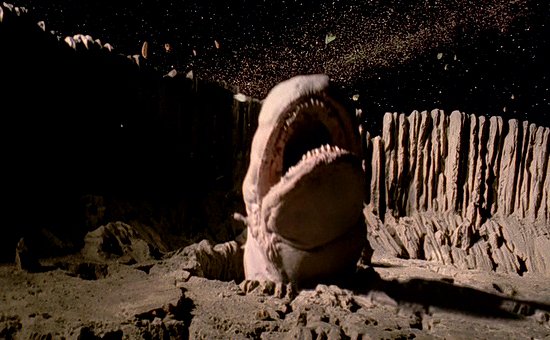The Weirdest Asteroid In Space
Everyone's favorite cub reporter takes his patented harebrained
hi-jinks into outer space in Jimmy Olsen #50, (January
1961), reflecting the space mania of the day if not necessarily
an understanding of rocketry, physics or indeed reality
as we know it.
We begin at an unnamed Metropolis museum (presumably its
Museum of Natural History), where a likewise unnamed professor
is giving Jimmy a sneak peek at the new "World's Biggest
Beasts" exhibit. Jimmy promises to give the exhibit
a good write-up in the Daily Planet, at least until he reads
a plaque that disturbs his sensibilities.

That's right, based on a science book he read in grade
school -- or maybe a special he saw on TV once -- Jimmy's
decided he knows more about zoology than a bona-fide scientist
(hey, the guy's got a white lab coat and everything!). And
just to show off the power of the press, our boy actually
issues an ultimatum; change the exhibit to suit me, or I'll
ruin you in the papers. Luckily, this is just as work of
fiction, since we know no real-life journalist would ever
let personal opinion cloud his reporting, and no scientist
would even consider fudging the facts to win media approval.
Next on Jimmy's to-do list is the premiere of a new science
fiction film. When he arrives, the producer has an unusual
request...
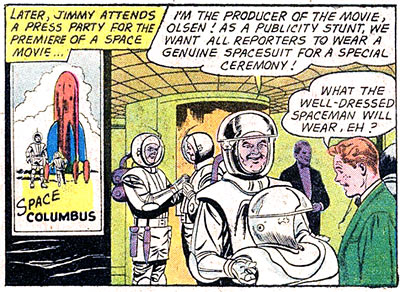
That's right, he expects the reporters who arrived to cover
the opening to help him market the film with a publicity
stunt. Luckily as we've already seen, Jimmy has no grasp
of the concept of journalistic integrity, so he readily
agrees. Which is good news for the movie studio, as they
probably spent a fortune on those "genuine" spacesuits
complete with "oxygen tanks, helmet, radio and a utility
belt holding a flashlight, signal-flare, knife and rope!"
Yup, that's a genuine spacesuit alright; no self-respecting
astronaut would ever blast off without his flashlight and
signal flare to aid him in the inky vacuum of space.
The "starting signal" for the movie will be the
launch of an actual "space rocket" from an adjacent
parking lot (hope you didn't park your Edsel too close!).
Naturally as soon as everyone's looking the other way, Jimmy
decides to sneak into the rocket, with Clark Kent
close behind whining, "Jimmy! Nobody is allowed inside!"
(Really? Then why are you coming along, Clark?
And how many Planet reporters does it take to cover a movie
opening, anyway?)
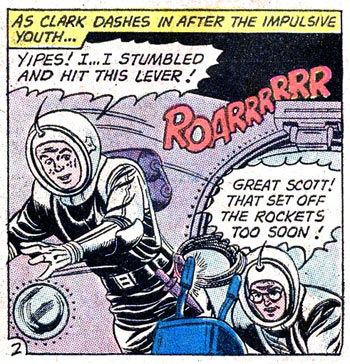
Jimmy accidentally trips a lever that initiates the launch...just
like the levers the real astronauts use to launch their
rockets from inside their capsules. Look, just play along,
okay?
Helpless against the pull of "high-speed g-forces,"
the two pals are well out of Earth orbit before zero gravity
allows them to bail out. In one of those little time paradoxes
so common to comics, Clark tells Jimmy they're going to
eject after they've already done it.
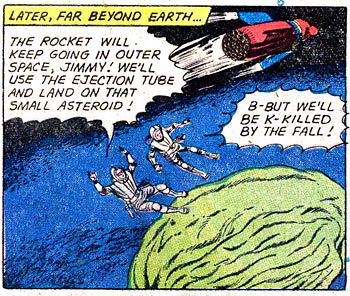
Jimmy needn't worry; the mild gravity of the asteroid allows
them to float down "as gentle as balloons." Incidentally,
we'll just assume that staying in the rocket would have
been somehow instantly fatal, as leaving it to rely on what
air exists in the spacesuits will merely prove eventually
fatal.
Ever the resourceful lad, Jimmy lights his signal flare
-- which burns surprisingly well in the vacuum of space
-- in hopes of attracting the attention of astronomers.
Astronomers with very, very powerful telescopes. Maybe he
should just hold up his steno pad with a "Help, We're
Stuck on An Asteroid" message written on it.
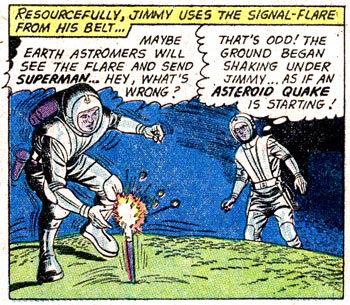
A sudden quake shakes Jimmy off the asteroid, so Clark
surreptitiously raises his helmet's visor and uses heat
vision to detonate a passing asteroid. Shockwaves from the
blast bring Jimmy back down again while Clark uses his x-ray
vision to determine the reason for the tremor. "Great
Scott!" he marvels, "It's unbelievable!"
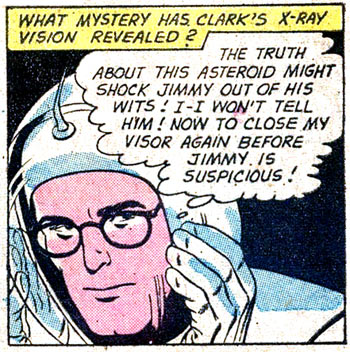
I'm not sure why we're suddenly so worried about Jimmy's
wits. It's not like he hasn't already gotten pretty far
in life without any. Indeed, their absence would actually
seem to be a help when it comes to getting through this
story.
With nothing better to do -- and a seemingly inexhaustible
supply of air in their tanks -- the two astro-reporters
take off on a hiking tour of the asteroid, discovering a
series of odd landmarks along the way.
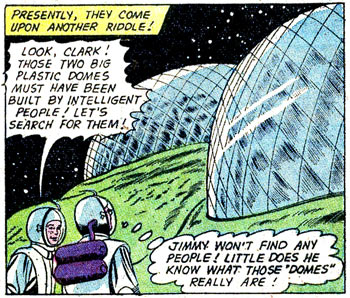
By now, astute readers have already guessed where all this
is going, but as "The Empire Strikes Back" is
still 19 years from release, poor Jimmy hasn't a clue, not
even when he comes across this suspicious-looking "cave"
with "ivory columns."
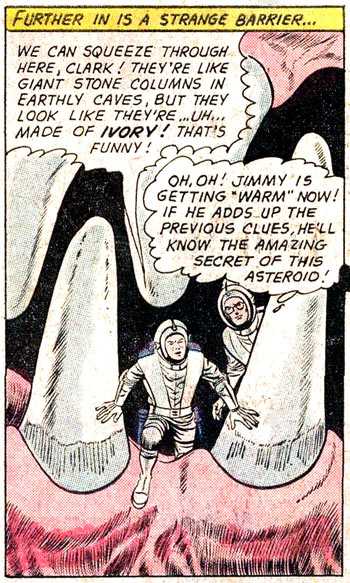
Accidentally dropping his flashlight on the "floor"
of the "cave", Jimmy triggers another tremor,
this one followed by an "ULG-G-G-G-G" sound and
a fiery wind that blows the two men back out the way they
came. Jimmy catches on at last, just in time to see the
true nature of the "asteroid"...
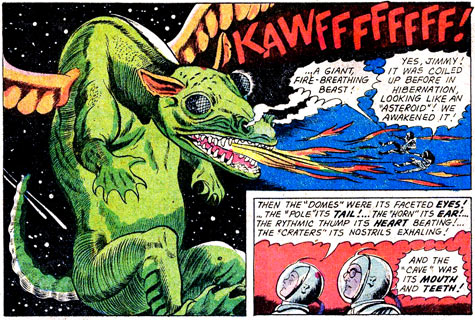
Tumbling dizzily in space, Jimmy passes out, at last giving
Clark the opportunity to switch to Superman and take action.
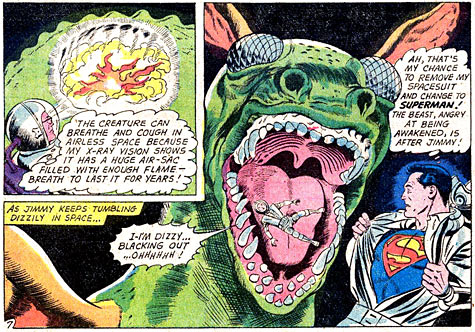
Thinking fast, Superman juggles a collection of brightly-colored
meteorites in front of the beast, lulling it back into hibernation.
Then he collects Jimmy and flies him back to Earth, changing
to Clark again in time to "wake up" beside young
Olsen. The movie producer has no hard feelings, since Jimmy's
little stunt has drawn in record crowds (nothing like a
couple of tragic deaths in space to move tickets, folks!)
Having somehow reasoned that this little episode has some
bearing on whales and Bible characters, Jimmy returns to
the museum to apologize to the professor for ever having
doubted him. When he describes the incident that changed
his mind, it's his turn to get laughed at.

Naturally, space travel would have been very much on the
minds of young comic readers when this issue hit the stands.
The Mercury 7 astronauts had been major celebrities since
their selection two years earlier, and a few months after
this issue, in May of 1961, Alan Shepard would
become the first American in space, his suborbital flight
in Freedom 7, setting the stage for JFK
to deliver his famous "Man on the Moon" speech
later that same month.
Hitting on the space theme, then, was a sure-fire way to
sell books, but I can't help feeling that in the long run,
stories like this kind of took away from the magic of it
all. Not because it's silly -- which it is -- but because
over time these stories made space travel seem as routine
as a trip to the supermarket. The Mercury 7 astronauts were
supposed to be the brightest, fittest men in America to
make the journey to space, but as early as 1958 Clark Kent
(a known wimp) and Lois Lane (a girl!)
were traveling into orbit with a rocket full of similarly
unremarkable reporters in the story that introduced Brainiac.
NASA's space suits were supposed to be top-secret technological
marvels, and here a Hollywood producers hands them out like
party hats. By the time the Mercury and Gemini astronauts
made it into space, it seemed like everybody and his brother
had already been there more than once.
Of course it wasn't just DC -- Marvel's Reed Richards
turned space travel into a glorified family picnic, dragging
along his girlfriend and her teenage brother. When
Neil Armstrong finally stepped foot on the Moon,
he'd been preceded by a long list of superheroes, sidekicks
and supporting casts, so it's hard to imagine the Apollo
program having the impact in those fictional worlds that
it did in our own. Why, one wonders, did American taxpayers
in those realities continue funneling money to NASA when
we already knew what was "out there," were already
rubbing elbows with Thanagarians, Martians, Kree and Skrulls?
Why would we even want to go poking around in space if we
knew there were surprises like Galactus out there waiting
for us?
But what the heck, it's all in fun. If nothing else, it's
worth the ride for the gorgeous Curt Swan artwork, especially
the sequence where we learn the "asteroid" is
really a fantastic, giant space-beast, waking from its slumber
to angrily snap at our heroes. Awesome stuff, even it's
obviously too corny to ever be used in a "legitimate"
science fiction story. Right?
